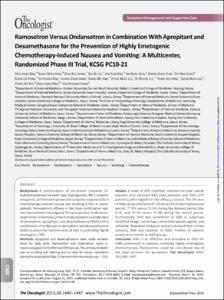KUMEL Repository
1. Journal Papers (연구논문)
1. School of Medicine (의과대학)
Dept. of Internal Medicine (내과학)
Ramosetron Versus Ondansetron in Combination With Aprepitant and Dexamethasone for the Prevention of Highly Emetogenic Chemotherapy-Induced Nausea and Vomiting: A Multicenter, Randomized Phase III Trial, KCSG PC10-21
- Keimyung Author(s)
- Park, Keon Uk
- Department
- Dept. of Internal Medicine (내과학)
- Journal Title
- Oncologist
- Issued Date
- 2015
- Volume
- 20
- Issue
- 12
- Keyword
- Ramosetron; Ondansetron; Aprepitant; Nausea; Vomiting; Chemotherapy
- Abstract
- Background. A combination of serotonin receptor (5-
hydroxytryptamine receptor type 3) antagonists, NK-1 receptor
antagonist, and steroid improves the complete response (CR) of
chemotherapy-induced nausea and vomiting (CINV) in cancer
patients. Ramosetron’s efficacy in this triple combination regimen
has not been investigated.This prospective,multicenter,
single-blind, randomized,phaseIII studycomparesacombination
of ramosetron, aprepitant, and dexamethasone (RAD) with a
combination of ondansetron, aprepitant, and dexamethasone
(OAD) to prove the noninferiority of RAD in controlling highly
emetogenic CINV.
Methods. Aprepitant and dexamethasone were orally administered
for both arms. Ramosetron and ondansetron were intravenouslygiventotheRADandOADgroups.
Theprimaryendpoint
was no vomiting and retching and no need for rescue medication
duringtheacuteperiod(day1);thenoninferioritymarginwas215%.
Results. A total of 299 modified intention-to-treat cancer
patients who received RAD (144 patients) and OAD (155
patients) were eligible for the efficacy analysis. The CR rates
ofRADversusOADwere97.2% versus 93.6% during the acute
period, 77.8% versus 73.6% during the delayed period (day
2–5), and 77.1% versus 71.6% during the overall period.
Furthermore, RAD was noninferior to OAD in subgroups
stratified by age, cancer type, chemotherapeutic agents, and
schedule. Repeated measures analysis showed that in male
patients, RAD was superior to OAD. Profiles of adverse
events were similar in both groups.
Conclusion.RAD is as effective and tolerable as OAD for
CINV prevention in patients receiving highly emetogenic
chemotherapy. Ramosetron could be considered one of
the best partners for aprepitant.
- Keimyung Author(s)(Kor)
- 박건욱
- Publisher
- School of Medicine
- Citation
- HYO JUNG KIM et al. (2015). Ramosetron Versus Ondansetron in Combination With Aprepitant and Dexamethasone for the Prevention of Highly Emetogenic Chemotherapy-Induced Nausea and Vomiting: A Multicenter, Randomized Phase III Trial, KCSG PC10-21. Oncologist, 20(12), 1440–1447. doi: 10.1634/theoncologist.2015-0128
- Type
- Article
- ISSN
- 1083-7159
- Appears in Collections:
- 1. School of Medicine (의과대학) > Dept. of Internal Medicine (내과학)
- 파일 목록
-
-
Download
 oak-2015-0196.pdf
기타 데이터 / 1.57 MB / Adobe PDF
oak-2015-0196.pdf
기타 데이터 / 1.57 MB / Adobe PDF
-
Items in Repository are protected by copyright, with all rights reserved, unless otherwise indicated.